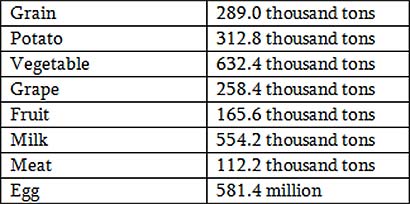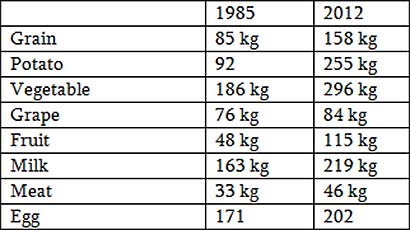It is very important to have accurate statistics for working out country’s development strategy. It allows specialists to assess the situation and work out development strategy through analyses and comparisons.
Agriculture has its special place among many failed spheres in Armenian reality. This fact can be definitely proved after assessing the social situation of farmers, monotone growth of agricultural land turning into desert, emigration from villages. This is an undeniable reality, but what the official numbers show.
The official website of the Government State Committee of the Real Estate Cadastre says that there are 481.8 thousand hectares of agricultural land in Armenia, 152.6 thousand hectares out of which are irrigated. National statistics says that in 2012 the number of cultivated agricultural land is only 67.7 percent. It is not difficult to calculate that in 2012, 326.2 thousand hectares of land was cultivated on agricultural purposes.
Now, according to the same statistics, we see how much crop yield half-irrigated 326.2 thousand hectares were provided in 2012.

Ordinary citizens cannot understand those numbers; the only people who are aware of the field will conceive the numbers. Many people, especially in rural areas, can only be surprised by the fact that parallel to the reduction of developed land, the volume of agricultural products are incredibly being increased.
Let us compare Independent Armenia’s agriculture and agricultural products with the ones of Soviet years. It is not a secret that Soviet agriculture was in a totally different level. Plots were large which today’s government has been trying to get through co-operatives. There were no problems related to agricultural machinery, irrigation, pesticide, fertilizer. Crop rotation and harvesting were conducted. Every year innovations of treatment and pesticide were introduced. Therefore, agriculture was a strategic field and was duly subsidized by the state.
However, when we compare the official numbers of agricultural products of the Soviet Armenia with the statistics of Independent Armenia, we can see that during Soviet years people did not understand the agriculture or did not know how to deal with the numbers. Let us bring 1985 indicators of agricultural products of Soviet Armenia under the condition of 100 percent cultivation and 303.0 thousand hectares land irrigation.

As it is accepted to say, the numbers are more than vivid. However, it is unclear what meat production with live weight means. Logically, the farmer’s per cow is calculated as meat production with live weight per year.
Finally, we can calculate the primary agricultural products per capita accepting 3.4 million in 1985 and 2, 87 million present.

Hence, from these numbers we can figure out why, when, Sergo Karapetyan, Minister of Agriculture, in his reports constantly mentions that these numbers are based on the official data of statistical service and his analysis are based on these numbers.
The question arises as to how these numbers are generated.
The Ministry of Agriculture demands numbers from the regional governors, the regional governors from the community governors, and the community governors from their secretaries. A community governor, who did not want to identify himself, in private conversation said the number they wanted we gave and no one could verify its accuracy.
Ministry of Agriculture provides these numbers to the statistical service; the latter announces them as state data. Then, Ministry of Agriculture, referring to the official statistical data, reports that these numbers are not theirs but belong to the national statistical service.
These numbers may also have other origins. When a farmer applies to get an agricultural loan, the bank requires to submit a credit program. Farmers multiply their expected harvest for several times in the program not to face any problems to get a loan. These numbers are being put into circulation and reached the statistical service.
If in 2012 the failed attempt of elite seeds of wheat did not prevent the rise of digital indicators of grain production in Armenia, it can be assumed that 2013 hail will not hinder the growth of the numbers of the Minister of Agriculture.
Therefore, there is one truth; the numbers will not support the country’s food security.
